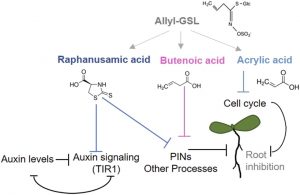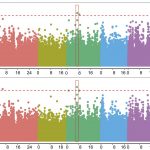Allyl-GSL Catabolites and Root Development
 In order to survive attacks by pathogens and herbivores, plants have developed a variety of defense mechanisms and resistance strategies, including the production of defensive chemicals. Such defense chemicals, however, can have detrimental effects on growth or can introduce ecological costs by attracting specialized attackers. Therefore, maximizing the effectiveness while limiting the detriments of these defense chemicals, requires a central coordination with the developmental programming of the plant. Glucosinolates (GSLs) are sulfur-containing defense metabolites produced in the Brassicales, including the model plant Arabidopsis. GSL accumulation and composition dramatically changes throughout the life of a plant and can alter the plant’s sensitivity to pathogens or insects. Previous work has indicated that specific GSLs may function as signals to provide direct feedback regulation within the plant to calibrate defense and growth. These GSLs include allyl-GSL, a defense metabolite that is one of the most widespread GSLs in Brassicaceae and has also been associated with growth inhibition. Katz et al. (10.1104/pp.20.00170) show that at least three separate potential catabolites of allyl-GSL or closely related compounds affect growth and development by different mechanisms.. Two of the catabolites, raphanusamic acid and 3-butenoic acid, differentially affect processes downstream of the auxin signaling cascade. Another catabolite, acrylic acid, affects meristem development by influencing the progression of the cell cycle. With each catabolite influencing a different component of root growth and development, the plant may be able to respond to the specific biotic events that are influencing defense metabolism: this could allow the plant to create a specific response that is optimal to any given environment
In order to survive attacks by pathogens and herbivores, plants have developed a variety of defense mechanisms and resistance strategies, including the production of defensive chemicals. Such defense chemicals, however, can have detrimental effects on growth or can introduce ecological costs by attracting specialized attackers. Therefore, maximizing the effectiveness while limiting the detriments of these defense chemicals, requires a central coordination with the developmental programming of the plant. Glucosinolates (GSLs) are sulfur-containing defense metabolites produced in the Brassicales, including the model plant Arabidopsis. GSL accumulation and composition dramatically changes throughout the life of a plant and can alter the plant’s sensitivity to pathogens or insects. Previous work has indicated that specific GSLs may function as signals to provide direct feedback regulation within the plant to calibrate defense and growth. These GSLs include allyl-GSL, a defense metabolite that is one of the most widespread GSLs in Brassicaceae and has also been associated with growth inhibition. Katz et al. (10.1104/pp.20.00170) show that at least three separate potential catabolites of allyl-GSL or closely related compounds affect growth and development by different mechanisms.. Two of the catabolites, raphanusamic acid and 3-butenoic acid, differentially affect processes downstream of the auxin signaling cascade. Another catabolite, acrylic acid, affects meristem development by influencing the progression of the cell cycle. With each catabolite influencing a different component of root growth and development, the plant may be able to respond to the specific biotic events that are influencing defense metabolism: this could allow the plant to create a specific response that is optimal to any given environment



